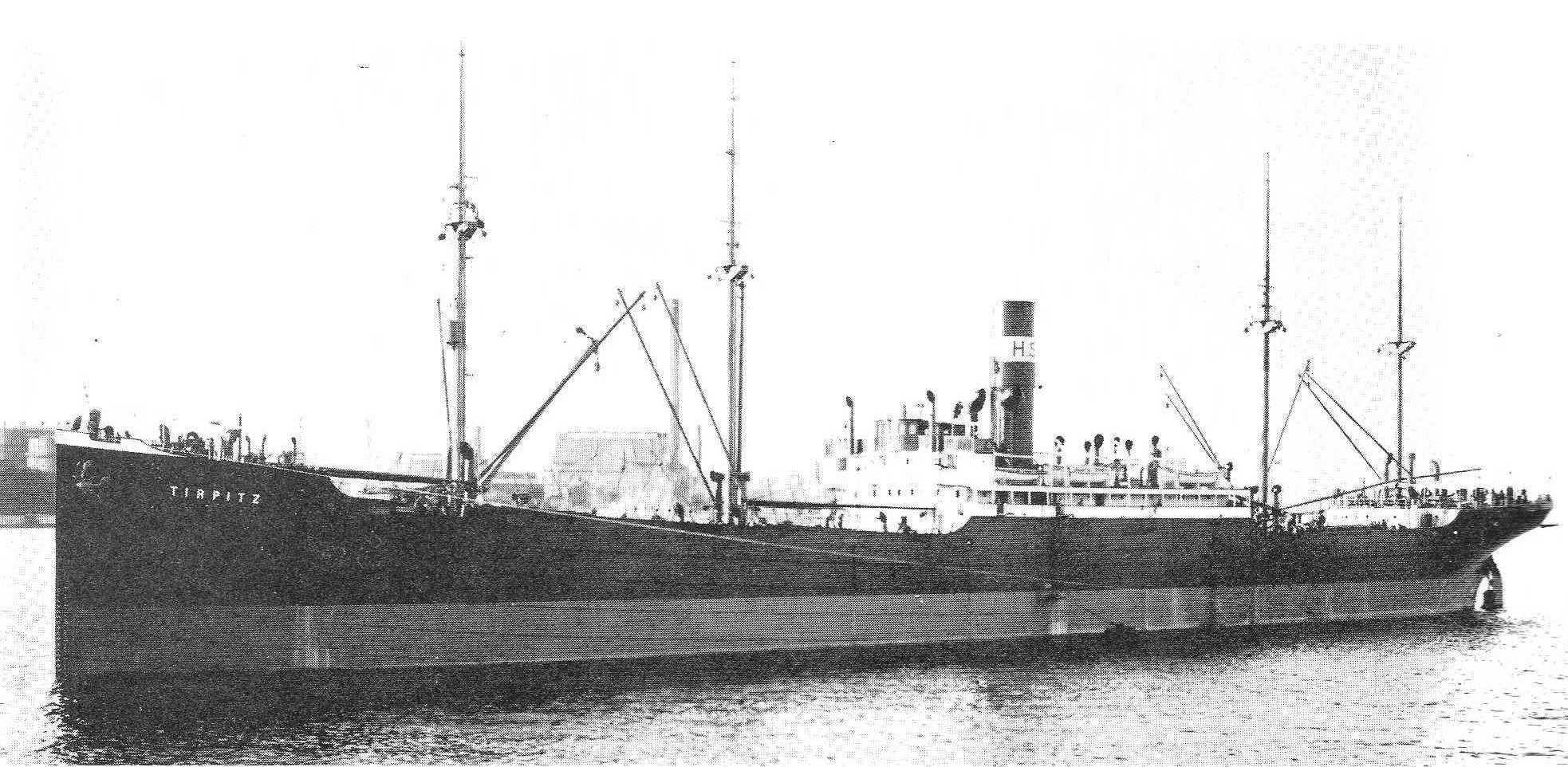KAKYAKUSEN
 (TIRPITZ, sister to HAVENSTEIN later TEISHO MARU)
(TIRPITZ, sister to HAVENSTEIN later TEISHO MARU)
Passenger-Cargo ship TEISHO MARU:
Tabular Record of Movement
© 2010-2017 Bob Hackett, Peter Cundall and Erich Muehlthaler
Revision 2
E 1920:
Flensburg, Germany. Laid down at Flensburger Schiffbau-Gesellschaft mbH & Co. KG (building number 357) as a 7,974-ton-passenger-cargo ship for Hugo Stinnes Schiffahrt GmbH Line, Hamburg.
11 May 1921:
Launched and named HAVENSTEIN.
16 August 1921:
Officially delivered to Hugo Stinnes Schiffahrt GmbH Line, port of registry is Hamburg.
24 November 1926:
Acquired by the Hamburg-Amerikanische Packetfahrt-Aktien-Gesellschaft (HAPAG) Line.
15 October 1938:
Departs Villa Constitution, Argentina.
28 October 1938:
Departs Buenos Aires, Argentina.
17 November 1938:
Departs Las Palmas, Canary Islands, Spain.
27 November 1938:
Arrives a Trieste, Italy.
25 July 1939:
Departs Osaka under command of merchant Captain D. Brummer.
31 July 1939:
Arrives at Dairen(former Port Arthur), Manchuria.
20 August 1939:
Due to unfavorable circumstances, unloading of cargo is finished only today.
21 August-6 September 1939.
Loads new cargo. Because of her slow speed of only 11 knots, HAVENSTEIN is considered unsuitable for use as a blockade runner. Therefore, the ship remains laid up at Dairen.
26 April 1941:
Requisitioned by the Kriegsmarine and placed at the disposal of the German naval attaché, Vizeadmiral (later Admiral) Paul Wennecker (former CO of Panzerschiff DEUTSCHLAND/LÜTZOW) and Deutscher Admiral Ostasien (German Admiral, East Asia) who time-charters the ship to the Japanese Government´s wholly owned Teikoku Senpaku K.K. (Imperial Steamship Co.), Tokyo. Renamed TEISHO MARU. Assigned called letters JWLQ. Later allocated to Kawasaki Kisen K.K., Kobe.
July 1941:
At Dairen.
25 October 1943:
12 miles off Oshima. At about 2300, LtCdr (later KIA) Charles F. Brindupke’s (USNA ’32) USS TULLIBEE (SS-284) attacks TEISHO MARU being escorted by auxiliary minesweeper MISAGO MARU No. 11 at 26-05N, 121-03E. TULLIBEE claims damage to TEISHO MARU, but she is unscathed. MISAGO MARU No. 11 carries out counterattacks, but without success.
8 November 1943:
Departs Takao in convoy No. 217 consisting of ICHIYO, TEISHO, KAZUURA, KYOKUZAN and KOSEI MARUs and twelve unidentified merchant ships escorted by auxiliary gunboat CHOHAKUSAN MARU and cable layer escort ODATE. The convoy later splits into two parts.
13 November 1943:
The first part of the convoy arrives at Moji. KOSEI MARU is detached before arrival and heads to Sasebo, arriving later that day.
14 November 1943:
The second part of the convoy arrives at Moji.
15 December 1943:
At 1500 departs Takao in convoy No. 227 also consisting of ORYOKU MARU.
16 December 1943:
At 0740 the convoy now consisting of SEATTLE, HORAISAN, GYOKUREI, KINREI, NIKKO, HOREI, NIGITSU and ORYOKU MARUs and KOTO MARU No. 2 GO escorted by destroyer NUMAKAZE departs Kirun.
22 December 1943:
Arrives at Moji.
4 August 1944:
At 1600, departs Moji for Takao in convoy MOTA-22 consisting of KENJO, GASSAN, HAKUSAN, TEIKA (ex-Vichy French CAP VARELLA), TERUKUNI, NANREI, GENKAI, TACHIBANA, TEIHOKU (ex-Vichy French PERSEE), HIOKI, MANSHU, SHIRANE, SHONAN and KOSHIN MARUs, DAIBOSHI MARU No. 6, YAMAMIZU MARU No. 2 and five unidentified merchant ships escorted by kaibokan ETOROFU, HIBURI, CD-25 and CD-32.
6 August 1944:
At about 0411, LtCdr (later Admiral/CinCPacFlt) Bernard A. Clarey’s (USNA ’34) USS PINTADO (SS-387) hits SHONAN MARU carrying elements of IJA's 25th Tank Regiment redeploying from Baotau, North China to Formosa, general cargo and four daihatsu barges, with three torpedoes. She sinks at 30-55N, 129-45E. Two crewmen and three gunners are KIA.
9 August 1944:
At about 1310, KOSHIN MARU also carrying elements of IJA's 25th Tank Regiment suffers an accidental explosion in her cargo and sinks at 26-10N, 124-15E. 28 crewmen are KIA.
10 August 1944:
At 1600, arrives at Kirun (Keelung), Formosa (Taiwan).
11 August 1944:
At 0330, departs Kirun.
12 August 1944:
5 km N of Takao. TEISHO MARU is lightly damaged in a collision near Mako, Formosa Strait. At 1800, arrives at Saei (Tsoying) harbor.
14 August 1944:
While anchoring off Saei, TEISHO MARU suffers serious bottom damage when driven aground in a typhoon at 22-40N, 120-14E.
12 September 1944:
TEISHO MARU is successfully refloated.
27 September 1944:
At 1900, enters Takao’s inner harbor and is moored alongside Pier No. 8. Commences repairs.
10 October 1944:
When news arrives about an approaching enemy task force, all ships able to leave the harbor are ordered out. TEISHO MARU´s engines and boilers are out of order, therefore, the ship remains alongside Pier No. 8 and prepares for battle.
12 October 1944:
Vice Admiral (later Admiral) Marc A. Mitscher’s (USNA ’10) Task Force 38 launches heavy air strikes against Formosa.
At 0330, an air-raid alarm is issued for the Takao area. The first wave of attackers arrives at 0730.
At 0817, four aircraft of the second wave closes TEISHO MARU from starboard while three others approach from portside. TEISHO MARU fights off the attackers with her machine guns.
At 1247, three vee-formations of three planes each close from starboard ahead. Though the number one plane is immediately shot down, the others attack in quick succession. TEISHO MARU is hit by three bombs near the forward deck gun mount and portside in forward part of No. hold. Both machine gun mounts are destroyed by the explosions.
A further bomb explodes on the pier besides the stern. The ship in now heavily afire. Flames are amplified by strong winds from WNW. As there is no hope to fight the flames, all hands are ordered to abandon ship. By 1600, the ship is completely aflame and settles to the harbor bottom alongside Pier No. 8.
Four shipboard gunners, seven Japanese and 20 German and Italian crew members are lost. On the pier, a cargo waiting for TEISHO MARU consisting of provisions for about 10 submarines for 12 weeks is also lost in the bombing.
18 October 1944:
The wreck of TEISHO MARU is further devastated in a gale.
Authors' Note:
Thanks go to Gilbert Casse of France.
Bob Hackett, Peter Cundall and Erich Muehlthaler
Back to
Ex-German Merchants in Japanese Service





